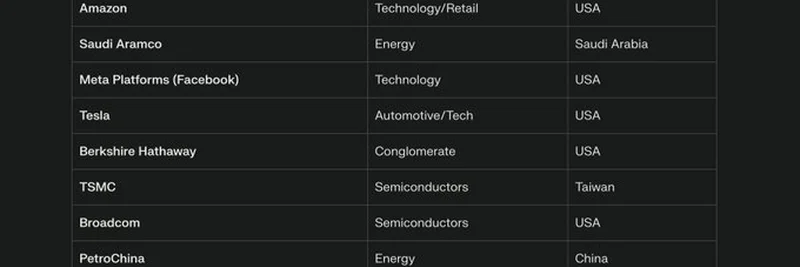Ever wondered which companies have reached the elite trillion-dollar club? A recent post on X by Hari (@_hrkrshnn) dives into this fascinating topic, revealing that out of the 12 companies with a market cap exceeding $1 trillion, a staggering 9 are American. But the story gets even more interesting when you dig into the roots of the remaining three. Let’s break it down and see why the U.S. seems to have a chokehold on this prestigious list.
The Trillion-Dollar Lineup
The image shared by Hari lists the current trillion-dollar companies, along with their industries and home countries:
- Apple, Microsoft, Nvidia, Alphabet (Google), Amazon, Meta (Facebook), Tesla, Broadcom, Berkshire Hathaway (USA) – These tech and conglomerate giants dominate the list, showcasing America’s strength in technology and innovation.
- Saudi Aramco (Saudi Arabia) – The energy sector’s lone representative, with a twist: it was founded in California by the Standard Oil Company of California (SOCAL) in 1933.
- TSMC (****)** – A semiconductor powerhouse, led by Morris Chang, who spent nearly four decades in the U.S. before founding the company.
- PetroChina (China) – The only company without a clear U.S. connection, though it briefly hit the trillion-dollar mark in 2007 before losing that valuation.
The American Connection
Hari’s post highlights a curious trend: 11 out of 12 companies in this club have significant cultural or historical ties to the U.S. Saudi Aramco’s American origins and TSMC’s founder’s long U.S. career suggest that the American economic system plays a huge role in building these giants. The U.S. dollar’s dominance in global trade and the deep liquidity of American markets create a fertile ground for companies to grow and sustain such massive valuations.
Why Does This Matter?
This concentration of trillion-dollar companies in or tied to the U.S. reflects more than just economic might. It points to a system where innovation, investment, and market access converge. For instance, TSMC’s success is partly due to its integration with the U.S. tech ecosystem, supplying chips to American companies like Apple and Nvidia. Meanwhile, Saudi Aramco’s early American roots gave it a head start in the global oil market.
The Outliers and Fluctuations
Not every company stays above the trillion-dollar mark forever. As Hari notes, Meta, Tesla, TSMC, Broadcom, and Berkshire Hathaway have crossed this threshold but can dip below it due to stock market fluctuations. PetroChina’s brief stint in the club in 2007 shows that even massive players can struggle to maintain that valuation without sustained growth or market support.
What’s Next for the Trillion-Dollar Club?
The discussion on X suggests this dominance might not last forever. As global markets evolve, countries like China or emerging economies could challenge the U.S. lead if they build alternative financial systems or innovate at scale. For now, though, the American hustle—combined with a bit of global influence—keeps the trillion-dollar club looking like a stars-and-stripes party.
If you’re into meme tokens or blockchain, this economic dominance could influence where the next big crypto innovations take root. Stay tuned to meme-insider.com for more insights on how these market trends might shape the future of decentralized finance!




